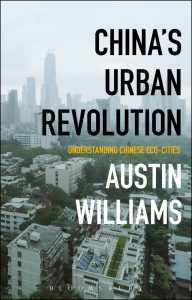Storm In Chandigarh
‘Storm In Chandigarh’ by Nayantara Sahgal; Penguin, 2008 (1st Edition, 1969); 248pp
Reviewed by Austin Williams | 5 February 2009
The province of Haryana was carved out of the Indian state of the Punjab in 1966 to form the Hindi-speaking 17th state of India. Even though it became independent, Haryana continues to be allied to the Punjabi-speaking Punjab… or what is left of it after it was divided almost in half. Forty years later and Haryana is now a dynamic industrial base with Shanghai-like skylines at Gurgaon and major investments in IT and transportation, whereas the Punjab is still primarily known for its agricultural output, with over 80 per cent of the land given over to farming. The fact that Haryana was getting mast of the infrastructural investment was pretty clear from the outset as by 1970, 100 per cent of all rural areas in Haryana had grid-supply electricity. Both the Punjab and Haryana are administered by the joint capital of Chandigar which was built to replace the Punjab capital of Lahore (ceded to Pakistan at Partition).
Chandigar is a grid city, often ascribed to have been designed by Le Corbusier (responsible for many of the city’s powerful buildings, not least of all the Punjab and Haryana Secretariat, which continues to jointly administer the state). But Chandigarh was actually the result of many others’ designs; including his lesser-feted cousin, Pierre Jeanneret; English architects Maxwell Fry and Jane Drew as well as Indian architects Sharma, Prakash et al. By the time of Haryana’s notional “succession” – the time that this book is set – only Phase One would have been complete. Its modern architecture was a radical and positive statement about the progressive potential for the newly emerging state… and for the country as a whole. Jawaharlal Nehru proclaimed its Modernist aims, describing a new city to be “symbolic of the freedom of India, unfettered by the traditions of the past”
Written in 1969, this novel has these erstwhile contemporary issues as the backdrop to the story. Indeed, Nehru is Sahgal’s uncle. However, for those assuming – like me – that the “Storm” in the title expressed the looming political violence of the Punjab carve-up, you will be sadly mistaken. Such intercommunal violence barely materializes… one man getting hit on the head by a stone left me feeling a little short-changed. Actualy, the storm relates to the emotional, sexual and psychological storms brewing in a tale of interpersonal hang-ups.
The characters are couples, each with their particular marital problems and character shortcomings: primarily Jit and Mara; and Inder and Saroj. The main narrative thread is from the perspective of the rather insufferably ‘moral’ daydreamer Vishal Dubey, a Delhi-based civil servant who gets offered the job of overseeing the Haryana transition. He has been having an affair with Gauri, wife of a best friend, but accepts the posting to escape the monotony of it all… curiously also passing up an opportunity to make a real escape to a Boston university. (Such are the many ‘devices’ that serve as notional plot development, but are rather ham-fisted ways of making a ‘point’ about commitment, duty, idealism, etc).
Writing in 1973, one critic, K S Srinivasalyengar wrote: “Mrs Saghal’s feelings for politics and her command over English are rather more impressive than her art as a novelist. There is too much contriving, and the principal characters are hardly convincing; and there are satirical patches that stand out as thought they have been lifted from Mrs. Saghal’s Journalism.” I couldn’t agree more; but the linguistic flourishes do serve to raise this book above the norm.
The intricacies of the extramarital dilemmas are pondered ad nauseum: Westernised Mara falls into an affair with boring Inder; Dubey falls into a platonic relationship with Saroj: it all seems slightly contrived. The most interesting element is Inder’s repressive inability to forgive his wife for having had sex prior to marriage. His rage turns to violence against her and then, ironically, he falls into the arms of worldly Mara. This is clearly a book of manners – and of 60s Indian feminism in particular – and as such, it is hardly surprising that it has dated. Even though the writing is, at times, very melodic, the whole thing could have been handled more deftly.
The soul-searching pillow-talk that passes for conversational narrative is reminiscant of a racy Mills and Boon, circa 1955. Or more accurately, it is an Indian “Brief Encounter”. Remember that great closing scene with Celia Johnson and her husband (played by Cyril Raymond):
“You’ve been a long way away.”
“Yes.”
“Well, whatever it was, thank you for coming back to me.”
“Storm in Chandigarh” the classic tale of a woman – several women – striving to break the ties that bind. Given that it was written more than 40 years ago, maybe this isn’t surprising. All in all, this is a well-written and, at times, fascinating account of women’s position in a repressive society, but for me, it was too subdued and tangential. There are some great passages, interesting insights and memorable turns of phrase. As a novel however, it isn’t very good.






